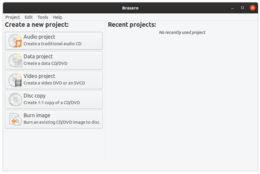cdrdao
 cdrdao reading a CD | |
| Developer(s) | Andreas Muller, Jonas Munsin, Manuel Clos, Denis Leroy |
|---|---|
| Written in | C++ |
| Operating system | Windows, Linux, macOS, Unix-like |
| Available in | English |
| Type | Disc imaging |
| License | GPL 2.0 Or Later |
| Website | cdrdao |
cdrdao (“CD recorder disc-at-once”) is a free and open source utility software application for authoring and ripping of audio and data CD-ROMs.[1] It is licensed under GPL-2.0 or Later.[2] The application is available for several operating systems, including Linux, Windows, and macOS, and has been reported to work on other operating Unix-based operating systems.[3]
cdrdao runs from command line and has no graphical user interface. Several programs for authoring and writing CDs depend on cdrdao and provide a GUI, such as Brasero, K3b. cdrdao powers Brasero, the default CD application for the GNOME desktop until around 2013.[4][5]
Features

Cdrdao is capable of reading and writing audio, data, and mixed audio/data discs.[1] It records audio or data CD-Rs in disk-at-once[6] mode based on a textual description of the CD contents, known as a TOC (table of contents) file that can be created and customized inside a text editor. When reading CDs, cdrdao creates a binary dump of the data inside a BIN file and uses the TOC file to index it. The TOC file can be converted to a CUE file using the included toc2cue command. [7] Using the TOC file, audio files can be burned to a disc in WAV format.[8] cdrdao can copy discs, blank discs, create disc image files, and check CDDB information.[9]
A key feature of cdrdao is its full control over the layout of the disc and its tracks.[10] This gives it the ability to create non-standard gaps between audio tracks that are different than two seconds in length and contain non-zero audio data. It can also create hidden tracks and intro tracks.[8]
References
- ^ 1.0 1.1 Schwarz, Michael, ed. (2002). Multitool Linux: practical uses for open source software. Boston, Mass.: Addison-Wesley. ISBN 978-0-201-73420-1.
- ^ "Cdrdao - Free Software Directory". Free Software Foundation. 12 April 2011. Retrieved 1 January 2024.
- ^ Mueller, Andreas; Munsin, Jonas; Clos, Manuel; Leroy, Denis (3 February 2023). "Cdrdao Homepage". Cdrdao. Retrieved 1 January 2024.
- ^ Ryan, Paul (20 March 2009). "Hands-on: GNOME 2.26 brings incremental improvements". Ars Technica. Retrieved 1 January 2024.
- ^ Wallen, Jack (29 November 2009). "Simple Linux disk burning with Brasero". ghacks.net. Retrieved 1 January 2024.
- ^ Rankin, Kyle (2006). Linux multimedia hacks: tips & tools for taming images, audio, and video (First ed.). Beijing: O'Reilly. ISBN 978-0-596-10076-6.
- ^ Ensom, Tom (January 2021). "Disk Imaging Guide" (PDF). Time-based Media Conservation, Tate. Retrieved 1 January 2024.
- ^ 8.0 8.1 Nguyen, Binh (26 July 2015). Linux Dictionary. Fultus Corporation. p. 378.
{{cite book}}: CS1 maint: date and year (link) - ^ Siever, Ellen, ed. (2009). Linux in a nutshell: a desktop quick reference (Sixth ed.). Beijing Köln: O'Reilly. ISBN 978-0-596-15448-6.
- ^ St. Pierre, Preston (18 November 2004). "Linux CD/DVD Recording". Linux.com. Retrieved 1 January 2024.
External links
- CS1 maint: date and year
- Free optical disc authoring software
- Free software programmed in C++
- Console CD ripping software
- Linux CD ripping software
- Software using the GPL license
- Windows software stubs
- Macintosh software stubs
- Free and open-source software stubs
- Storage software stubs
- Multimedia software stubs